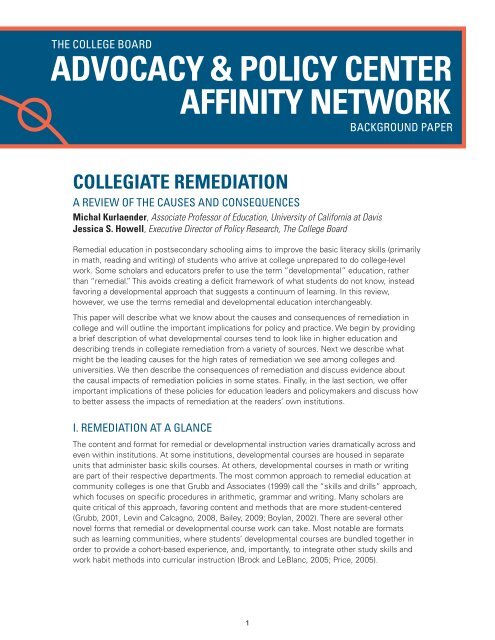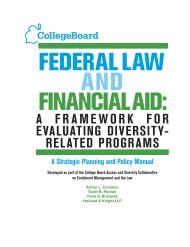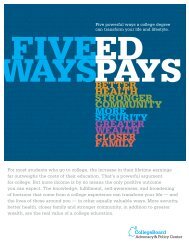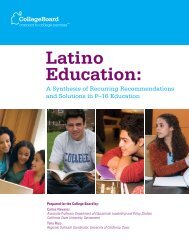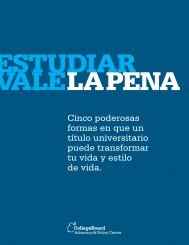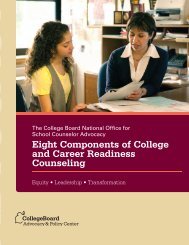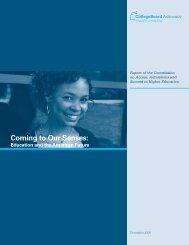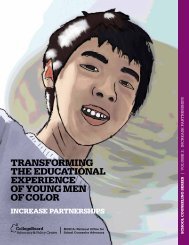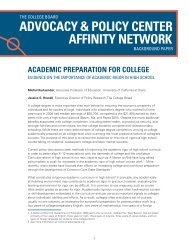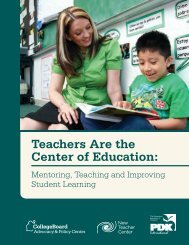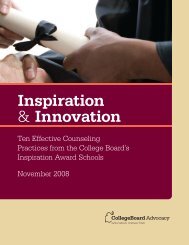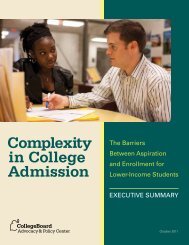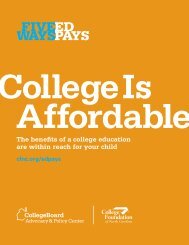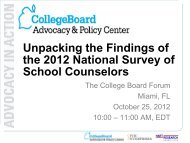Collegiate Remediation: A Review of the Causes and Consequences
Collegiate Remediation: A Review of the Causes and Consequences
Collegiate Remediation: A Review of the Causes and Consequences
Create successful ePaper yourself
Turn your PDF publications into a flip-book with our unique Google optimized e-Paper software.
The College Board<br />
Advocacy & Policy Center<br />
Affinity Network<br />
Connecting K–12 <strong>and</strong> Postsecondary Background Institutions Paper<br />
COLLEGIATE REMEDIATION<br />
A REVIEW OF THE CAUSES AND CONSEQUENCES<br />
Michal Kurlaender, Associate Pr<strong>of</strong>essor <strong>of</strong> Education, University <strong>of</strong> California at Davis<br />
Jessica S. Howell, Executive Director <strong>of</strong> Policy Research, The College Board<br />
Remedial education in postsecondary schooling aims to improve <strong>the</strong> basic literacy skills (primarily<br />
in math, reading <strong>and</strong> writing) <strong>of</strong> students who arrive at college unprepared to do college-level<br />
work. Some scholars <strong>and</strong> educators prefer to use <strong>the</strong> term “developmental” education, ra<strong>the</strong>r<br />
than “remedial.” This avoids creating a deficit framework <strong>of</strong> what students do not know, instead<br />
favoring a developmental approach that suggests a continuum <strong>of</strong> learning. In this review,<br />
however, we use <strong>the</strong> terms remedial <strong>and</strong> developmental education interchangeably.<br />
This paper will describe what we know about <strong>the</strong> causes <strong>and</strong> consequences <strong>of</strong> remediation in<br />
college <strong>and</strong> will outline <strong>the</strong> important implications for policy <strong>and</strong> practice. We begin by providing<br />
a brief description <strong>of</strong> what developmental courses tend to look like in higher education <strong>and</strong><br />
describing trends in collegiate remediation from a variety <strong>of</strong> sources. Next we describe what<br />
might be <strong>the</strong> leading causes for <strong>the</strong> high rates <strong>of</strong> remediation we see among colleges <strong>and</strong><br />
universities. We <strong>the</strong>n describe <strong>the</strong> consequences <strong>of</strong> remediation <strong>and</strong> discuss evidence about<br />
<strong>the</strong> causal impacts <strong>of</strong> remediation policies in some states. Finally, in <strong>the</strong> last section, we <strong>of</strong>fer<br />
important implications <strong>of</strong> <strong>the</strong>se policies for education leaders <strong>and</strong> policymakers <strong>and</strong> discuss how<br />
to better assess <strong>the</strong> impacts <strong>of</strong> remediation at <strong>the</strong> readers’ own institutions.<br />
I. <strong>Remediation</strong> at a Glance<br />
The content <strong>and</strong> format for remedial or developmental instruction varies dramatically across <strong>and</strong><br />
even within institutions. At some institutions, developmental courses are housed in separate<br />
units that administer basic skills courses. At o<strong>the</strong>rs, developmental courses in math or writing<br />
are part <strong>of</strong> <strong>the</strong>ir respective departments. The most common approach to remedial education at<br />
community colleges is one that Grubb <strong>and</strong> Associates (1999) call <strong>the</strong> “skills <strong>and</strong> drills” approach,<br />
which focuses on specific procedures in arithmetic, grammar <strong>and</strong> writing. Many scholars are<br />
quite critical <strong>of</strong> this approach, favoring content <strong>and</strong> methods that are more student-centered<br />
(Grubb, 2001, Levin <strong>and</strong> Calcagno, 2008, Bailey, 2009; Boylan, 2002). There are several o<strong>the</strong>r<br />
novel forms that remedial or developmental course work can take. Most notable are formats<br />
such as learning communities, where students’ developmental courses are bundled toge<strong>the</strong>r in<br />
order to provide a cohort-based experience, <strong>and</strong>, importantly, to integrate o<strong>the</strong>r study skills <strong>and</strong><br />
work habit methods into curricular instruction (Brock <strong>and</strong> LeBlanc, 2005; Price, 2005).<br />
1
Trends in College <strong>Remediation</strong><br />
How pervasive is remedial course-taking at colleges <strong>and</strong> universities? Estimates from <strong>the</strong> most<br />
recent national longitudinal study <strong>of</strong> high school graduates that enter postsecondary studies<br />
suggest that nearly a quarter <strong>of</strong> all students entering four-year institutions require some<br />
remediation — some combination <strong>of</strong> reading, writing <strong>and</strong>/or math (Snyder, Tan <strong>and</strong> H<strong>of</strong>fman,<br />
2004). Rates are higher for some groups, particularly black <strong>and</strong> Hispanic students, <strong>and</strong> remedial<br />
course-taking is generally higher at two-year, open-access institutions, where many students<br />
begin <strong>the</strong>ir postsecondary study.<br />
Table 1:<br />
Rates <strong>of</strong> Remedial Course-Taking at Two-year <strong>and</strong> Four-Year Institutions for <strong>the</strong> High School<br />
Class <strong>of</strong> 2004, by Race/Ethnicity<br />
4-Year Institutions<br />
2-Year Institutions<br />
Reading Writing Math Reading Writing Math<br />
Total 16.2% 24.8% 25.8% 26.9% 29.8% 38.7%<br />
By Race/Ethnicity:<br />
White 15.1% 24.1% 23.7% 22.8% 27.2% 36.6%<br />
African American/Black 16.2% 19.9% 29.7% 34.5% 30.6% 40.5%<br />
Hispanic 22.2% 30.9% 36.2% 32.1% 34.5% 44%<br />
Asian 21.4% 33.5% 28.4% 40.1% 44.2% 46.4%<br />
Source: U.S. Department <strong>of</strong> Education, National Center for Education Statistics, Education Longitudinal Study <strong>of</strong> 2002 (ELS:<br />
2002). Estimates in this table are based on spring 2004 high school seniors who had enrolled in postsecondary education by 2006.<br />
There is strong evidence that <strong>the</strong>se national statistics grossly understate <strong>the</strong> need for remedial<br />
course-taking among college students. This is, in large part, because national studies such as<br />
<strong>the</strong> Education Longitudinal Study (ELS) rely on students’ self-reports to determine course-taking<br />
metrics. In fact, figures from large moderately selective public universities systems, such as <strong>the</strong><br />
California State University system, suggest that 60 to 65 percent <strong>of</strong> entering freshmen require<br />
some developmental course work in English, math or both (Kurlaender, Jackson <strong>and</strong> Howell,<br />
2011). Moreover, remediation is much more prevalent at community colleges than <strong>the</strong> selfreported<br />
data suggest (Perrin, 2006). Reports from <strong>the</strong> Community College Research Center<br />
indicate that it is “reasonable to conclude that two-thirds or more <strong>of</strong> community college students<br />
enter college with academic skills weak enough in at least one major subject area to threaten<br />
<strong>the</strong>ir ability to succeed in college-level courses” (Bailey, 2009).<br />
O<strong>the</strong>r college-readiness metrics based on high school preparation suggest that only one-third<br />
<strong>of</strong> graduating high school students have completed <strong>the</strong> course work <strong>and</strong> rigor necessary for<br />
success at four-year colleges <strong>and</strong> universities. Utilizing <strong>the</strong> National Assessment <strong>of</strong> Educational<br />
Progress (NAEP) 1998 study <strong>of</strong> 12th-grade students, Greene <strong>and</strong> Forster (2003), conclude that<br />
32 to 36 percent <strong>of</strong> 1998 high school graduates demonstrated college readiness. Even more<br />
troubling are <strong>the</strong> disparities in college readiness indicators by race/ethnicity.<br />
2
Assessing <strong>Remediation</strong> Need<br />
Most colleges utilize a variety <strong>of</strong> approaches to determine student pr<strong>of</strong>iciency for college-level<br />
work. At four-year institutions, students can typically demonstrate pr<strong>of</strong>iciency utilizing college<br />
entrance exams such as <strong>the</strong> SAT ® or ACT, or by meeting AP thresholds. When entrance exam<br />
scores do not meet pr<strong>of</strong>iciency thresholds, students may be given assessments in math <strong>and</strong><br />
English (reading <strong>and</strong> writing) in order to determine course placement (at some campuses <strong>the</strong>se<br />
are given in addition to entrance exams). While such assessments <strong>and</strong> placement procedures<br />
are st<strong>and</strong>ardized in some public higher education systems, <strong>the</strong>y are very institution- (or even<br />
department-) specific at o<strong>the</strong>rs. Colleges utilize different assessments <strong>and</strong> different cut<strong>of</strong>fs for<br />
determining pr<strong>of</strong>iciency, <strong>and</strong> for determining <strong>the</strong> level <strong>of</strong> remediation necessary (Merisotis <strong>and</strong><br />
Phipps, 2000; Bettinger <strong>and</strong> Long, 2007). At most four-year colleges, remediation is a one- or<br />
two-course sequence in math or English, respectively. At community colleges, however, students<br />
may be referred to developmental courses that may be three levels below college-level work<br />
(Bailey, 2009; Grubb, 2001).<br />
Compliance in <strong>Remediation</strong> Course-Taking<br />
For a variety <strong>of</strong> reasons, many students referred to developmental courses do not enroll in <strong>the</strong>m.<br />
First, some institutions do not enforce enrollment in developmental courses or make <strong>the</strong>m a<br />
prerequisite for enrolling in college-level courses, even for students who are directed into <strong>the</strong>se<br />
courses following assessment. Evaluating data from <strong>the</strong> community colleges participating in<br />
Achieving <strong>the</strong> Dream, Bailey (2009) finds that 21 percent <strong>of</strong> students referred to developmental<br />
math <strong>and</strong> 33 percent referred to developmental reading do not enroll in <strong>the</strong>se courses within<br />
three years <strong>of</strong> first registration. Second, some institutions, particularly community colleges<br />
where <strong>the</strong>re is a great dem<strong>and</strong> for developmental courses, do not <strong>of</strong>fer enough sections <strong>of</strong><br />
developmental skills courses to accommodate all students who need <strong>the</strong>m. Finally, many<br />
students who enroll in developmental courses fail to complete <strong>the</strong>m (Jenkins <strong>and</strong> Boswell, 2002).<br />
How many students complete a remedial course sequence? Again, from <strong>the</strong> Achieving <strong>the</strong><br />
Dream community colleges, 44 percent <strong>of</strong> students enrolled in developmental reading <strong>and</strong> 31<br />
percent enrolled in developmental math actually completed <strong>the</strong> developmental course sequence<br />
(Bailey, 2009). Utilizing data on members <strong>of</strong> <strong>the</strong> high school class <strong>of</strong> 1992 who enroll in college,<br />
68 percent <strong>of</strong> students needing remediation passed developmental writing requirements, 71<br />
percent passed reading <strong>and</strong> 30 percent passed developmental math courses (Attewell et al.,<br />
2006). In postsecondary systems where remediation is an enforced prerequisite to college-level<br />
course-taking, compliance is greater. For example, students in <strong>the</strong> California State University<br />
system who do not meet pr<strong>of</strong>iciency requirements are required to enroll in basic skills courses.<br />
Thus, compliance is closer to 80 percent (Garcia, 2012).<br />
II. The <strong>Causes</strong> <strong>of</strong> High <strong>Remediation</strong> Rates<br />
There are several plausible explanations for why some students might arrive in college<br />
unprepared to do college-level work.<br />
K–12 Schooling Experiences<br />
The accumulation <strong>of</strong> academic skills <strong>and</strong> preparation in high school is <strong>the</strong> single best predictor <strong>of</strong><br />
college outcomes (Long, Iatarola <strong>and</strong> Conger, 2008; Adelman, 1999, 2006). Yet, some students<br />
arrive at college having attended elementary <strong>and</strong> secondary schools <strong>of</strong> low quality or with<br />
weak academic rigor. Students who attend poor-quality schools may not receive <strong>the</strong> necessary<br />
grounding in core subjects such as English <strong>and</strong> math to engage successfully in college-level work<br />
3
(Achieve, 2004). Of course, students may also come to college with deficiencies in core subjects<br />
even if <strong>the</strong>y attend adequate or superior schools, because <strong>of</strong> lack <strong>of</strong> attention to <strong>the</strong>ir studies,<br />
because <strong>of</strong> existing learning disabilities or perhaps because <strong>the</strong>y are English language learners.<br />
Lack <strong>of</strong> Information<br />
Students are also wildly misinformed about <strong>the</strong> skills necessary to succeed in college. A majority<br />
<strong>of</strong> high school students — regardless <strong>of</strong> <strong>the</strong>ir academic performance — report that <strong>the</strong>y will<br />
attend college. In fact, academic performance accounts for little <strong>of</strong> <strong>the</strong> variance in students’<br />
expected levels <strong>of</strong> educational attainment, suggesting that students’ actual grades in school <strong>of</strong>ten<br />
do not correlate with <strong>the</strong>ir educational expectations. Reynolds et al. (2006) found that between<br />
1976 <strong>and</strong> 2000 <strong>the</strong> percentage <strong>of</strong> high school seniors indicating that <strong>the</strong>y probably or definitely<br />
would complete at least a baccalaureate degree increased from 50 percent to 78 percent.<br />
Rosenbaum <strong>and</strong> o<strong>the</strong>rs have documented that high school seniors have little underst<strong>and</strong>ing <strong>of</strong><br />
what it takes to succeed in higher education (Rosenbaum, 2001; Deil-Amen <strong>and</strong> Rosenbaum,<br />
2002; Conley, 2005; Venezia, Kirst <strong>and</strong> Antonio, 2004).<br />
Misalignment between K–12 <strong>and</strong> Higher Education<br />
Given <strong>the</strong> high numbers <strong>of</strong> students who require remediation upon college entry, it is also<br />
becoming clear that <strong>the</strong> transition between high school <strong>and</strong> college is not seamless, <strong>and</strong> that our<br />
K–12 system is grossly misaligned with <strong>the</strong> expectations <strong>of</strong> colleges <strong>and</strong> universities (H<strong>of</strong>fman,<br />
Vargas, Venezia <strong>and</strong> Miller, 2007). Some fault <strong>the</strong> “wasted” senior year, during which many<br />
students experience less ra<strong>the</strong>r than more rigor in <strong>the</strong>ir academic program (Kirst, 2000; National<br />
Commission on <strong>the</strong> High School Senior Year, 2001). O<strong>the</strong>rs suggest that state performance<br />
st<strong>and</strong>ards are detached from those that might assist students in higher education (Venezia,<br />
Callan, Finney, Kirst <strong>and</strong> Usdan, 2005). Finally, still o<strong>the</strong>rs point out that <strong>the</strong> current accountability<br />
regime has focused attention in K–12 on meeting basic competency, for example in high school<br />
exit exams, perhaps at <strong>the</strong> expense <strong>of</strong> meeting <strong>the</strong> expectations <strong>of</strong> postsecondary schooling<br />
(Strong American Schools, 2008; Achieve, 2004). Recent efforts <strong>of</strong> <strong>the</strong> Common Core State<br />
St<strong>and</strong>ards (fur<strong>the</strong>r discussed below) suggest that this may be changing.<br />
4
III. <strong>Consequences</strong> <strong>of</strong> <strong>Remediation</strong><br />
There are important consequences <strong>of</strong> college remediation for both individuals <strong>and</strong> society.<br />
<strong>Remediation</strong> is costly, but <strong>the</strong> price <strong>of</strong> not assisting more young people in <strong>the</strong>ir pursuit <strong>of</strong> degree<br />
completion may be even higher. The earnings gap between college-educated <strong>and</strong> noncollegeeducated<br />
adults continues to grow (Baum, Ma <strong>and</strong> Payea, 2010), as do <strong>the</strong> labor market dem<strong>and</strong>s<br />
for more highly skilled workers (Goldin <strong>and</strong> Katz, 2008).<br />
Costs <strong>of</strong> <strong>Remediation</strong><br />
<strong>Remediation</strong> is expensive — to students, <strong>the</strong>ir families, colleges <strong>and</strong> taxpayers. There are large<br />
direct costs <strong>of</strong> providing remedial instruction in higher education for skills that should have been<br />
mastered in high school (Phipps, 1998). Many argue that this effectively requires taxpayers to<br />
pay double for mastery <strong>of</strong> <strong>the</strong> same literacy skills (Strong American Schools, 2008). The direct<br />
costs for developmental instruction differ depending on <strong>the</strong> institutions <strong>and</strong> on <strong>the</strong> personnel<br />
utilized to teach such courses. Developmental courses are <strong>of</strong>ten taught by low-paid adjunct or<br />
part-time instructors <strong>and</strong> are cheaper at lower-cost institutions such as community colleges (Levin<br />
<strong>and</strong> Calcagno, 2008). But <strong>the</strong>re are also many hidden costs to remediation — forgone earnings<br />
for remediated students who need a longer course <strong>of</strong> study to obtain <strong>the</strong>ir degrees — <strong>and</strong> <strong>the</strong>re<br />
are potential social costs for remediated students, such as frustration or low self-esteem (Deil-<br />
Amen <strong>and</strong> Rosenbaum, 2002), <strong>and</strong> <strong>the</strong> possibility <strong>of</strong> negative spillover effects for all students on<br />
account <strong>of</strong> weaker average skills among enrolled students at any given postsecondary institution<br />
(Hanushek, 2002).<br />
Older estimates <strong>of</strong> <strong>the</strong> costs <strong>of</strong> remediation suggest <strong>the</strong> total annual cost <strong>of</strong> remedial courses<br />
across all types <strong>of</strong> higher education institutions is between $1 billion <strong>and</strong> $2 billion (Breneman<br />
<strong>and</strong> Haarlow, 1998). More recent estimates calculate <strong>the</strong> annual cost <strong>of</strong> remediation at $1.9<br />
billion to $2.3 billion at community colleges <strong>and</strong> ano<strong>the</strong>r $500 million at four-year colleges (Strong<br />
American Schools, 2008).<br />
<strong>Remediation</strong> <strong>and</strong> College Outcomes<br />
Students who arrive at college in need <strong>of</strong> remedial or developmental course work are less<br />
likely to succeed — in <strong>the</strong>ir performance, persistence <strong>and</strong> degree completion — in college.<br />
For example, less than one-quarter <strong>of</strong> community college students in <strong>the</strong> National Educational<br />
Longitudinal Study (NELS) sample who enrolled in developmental education complete a degree<br />
or certificate within eight years <strong>of</strong> enrollment in college. In comparison, almost 40 percent<br />
<strong>of</strong> community college students in <strong>the</strong> NELS sample who did not enroll in any developmental<br />
education course complete a degree or certificate in <strong>the</strong> same time period (National Educational<br />
Longitudinal Study). Although <strong>the</strong> disparities in outcomes are not as great at four-year colleges,<br />
here too we see that students who require developmental course work are both less likely to<br />
finish <strong>and</strong> to take longer even if <strong>the</strong>y do, when compared with <strong>the</strong>ir peers who did not require<br />
remediation (Horn <strong>and</strong> Kojaku, 2001).<br />
But nei<strong>the</strong>r remedial programs nor developmental course work cause <strong>the</strong>se weaker outcomes.<br />
Such programs are intended to overcome <strong>the</strong> deficiencies that many students face, <strong>and</strong> it is<br />
<strong>the</strong>refore quite likely that academically unprepared students would fare even worse if <strong>the</strong>se<br />
programs did not exist. However, <strong>the</strong> research based on <strong>the</strong> effectiveness <strong>of</strong> remedial education<br />
programs is inconclusive at best. Part <strong>of</strong> <strong>the</strong> difficulty in assessing <strong>the</strong> impacts <strong>of</strong> remediation on<br />
collegiate outcomes is that students who require remediation are different from those who do<br />
not, making it difficult to isolate <strong>the</strong> effect <strong>of</strong> remediation on college outcomes from <strong>the</strong> o<strong>the</strong>r<br />
things that make <strong>the</strong>se students different. (Examples include weaker skills or less motivation.)<br />
In research that controls for students’ academic skills <strong>and</strong> o<strong>the</strong>r demographic characteristics,<br />
5
students in developmental courses at community colleges do as well as students who never<br />
participate in developmental education (Adelman, 1998; Attewell, Lavin, Domina, <strong>and</strong> Levey,<br />
2006). Attewell et al. (2006) find that, after controlling for student characteristics, students who<br />
enroll in reading developmental education are more likely to earn a degree than those who do<br />
not. Those who enroll in remedial math courses, however, were less likely to earn a degree than<br />
<strong>the</strong>ir peers who did not enroll in remedial math. The same authors find that at four-year colleges,<br />
participation in remedial course work has a 6 to 7 percent negative effect on degree completion.<br />
More recently, a body <strong>of</strong> work by social science researchers has attempted to overcome <strong>the</strong><br />
difficulties in comparing <strong>the</strong> outcomes <strong>of</strong> students placed in remediation to those who are not.<br />
This evidence is more compelling in many ways but still not without limitations.<br />
Causal Evidence on <strong>Remediation</strong> Policies<br />
There have been a h<strong>and</strong>ful <strong>of</strong> studies that utilize more rigorous quantitative methods <strong>and</strong><br />
detailed student-level administrative data from specific states to isolate a causal effect <strong>of</strong><br />
participating in remedial course work in college. The advantage <strong>of</strong> <strong>the</strong>se studies is that <strong>the</strong>y are<br />
able to overcome <strong>the</strong> main obstacle in evaluating remediation — a viable comparison group. As<br />
previously suggested, students are not placed in developmental courses in an arbitrary way; <strong>the</strong>y<br />
<strong>of</strong>ten have a host <strong>of</strong> o<strong>the</strong>r characteristics that are associated with both <strong>the</strong>ir need for remediation<br />
<strong>and</strong> <strong>the</strong>ir likelihood <strong>of</strong> success in college. These studies overcome this problem by establishing<br />
a comparison group for remediated students based on students who were very close to <strong>the</strong><br />
pr<strong>of</strong>iciency cut<strong>of</strong>f. The assumption is that those who passed, but just barely, are not that different<br />
from those who just barely did not pass <strong>and</strong> <strong>the</strong>refore needed remediation. As a result, <strong>the</strong><br />
evidence is most applicable regarding whe<strong>the</strong>r remediation “works” or “does not work” for<br />
students at <strong>the</strong> margin <strong>of</strong> needing it in <strong>the</strong> first place. Never<strong>the</strong>less, this research yields our best<br />
guess about whe<strong>the</strong>r remediation policies benefit students in need <strong>of</strong> extra skills.<br />
Using scores on <strong>the</strong> state-m<strong>and</strong>ated placement test to compare Texas students attending<br />
public institutions who scored just below <strong>and</strong> just above <strong>the</strong> cut<strong>of</strong>f for pr<strong>of</strong>iciency, Martorell <strong>and</strong><br />
McFarlin (2011) found that students requiring remediation did not have better odds <strong>of</strong> passing a<br />
college-level math course, transferring from a two-year to a four-year college, or completing <strong>the</strong>ir<br />
degree. In a similar study <strong>of</strong> Florida institutions, Calcagno <strong>and</strong> Long (2008) compared students<br />
just above <strong>and</strong> just below <strong>the</strong> cut<strong>of</strong>f for developmental courses <strong>and</strong> found that students required<br />
to take developmental courses in math (compared to similar students not required to do so)<br />
accumulated more total credits but were no more likely to complete college-level courses, to<br />
complete a certificate or AA degree or to transfer to a four-year university. Still, a third study<br />
employing a similar approach at one large university campus in <strong>the</strong> Nor<strong>the</strong>ast found a positive<br />
effect <strong>of</strong> remedial course-taking on later outcomes (Lesik, 2007).<br />
Bettinger <strong>and</strong> Long (2009) explored two-year <strong>and</strong> four-year colleges in Ohio, taking advantage<br />
<strong>of</strong> <strong>the</strong> fact that Ohio public institutions have different policies (test cut<strong>of</strong>fs) for demonstrating<br />
pr<strong>of</strong>iciency. They found that placement into remediation increased <strong>the</strong> probability <strong>of</strong> college<br />
persistence when comparing academically similar peers who were <strong>and</strong> were not required to take<br />
remedial courses. Most recently, Boatman <strong>and</strong> Long (2010) explored remediation placement at<br />
two-year <strong>and</strong> four-year institutions in Tennessee, finding important differences based on students’<br />
level <strong>of</strong> preparation. Their study was able to explore multiple cut<strong>of</strong>fs for different placements,<br />
<strong>and</strong> it found that students in need <strong>of</strong> less remediation fare worse when compared to similar<br />
students who passed <strong>the</strong> pr<strong>of</strong>iciency threshold. However, for students far<strong>the</strong>r below pr<strong>of</strong>iciency,<br />
remediation actually improved outcomes, particularly persistence through college. These results<br />
suggest that remedial <strong>and</strong> developmental courses function differently depending on students’<br />
level <strong>of</strong> academic preparedness, <strong>and</strong> <strong>the</strong>refore policies that may be beneficial for some students<br />
with different levels <strong>of</strong> academic preparedness may not be for o<strong>the</strong>rs.<br />
6
In sum, <strong>the</strong>se studies reveal at best a mixed bag <strong>of</strong> results, suggesting that students in need<br />
<strong>of</strong> remediation do no better (<strong>and</strong> at times slightly worse) when compared to similar students.<br />
The studies also suggest that perhaps <strong>the</strong> fact that we do not see consistent positive outcomes<br />
comparing students just above <strong>and</strong> just below pr<strong>of</strong>iciency cut<strong>of</strong>f may imply that <strong>the</strong> assessments<br />
we use for identifying remediation are not useful or sufficiently nuanced enough (Scott-<br />
Clayton, 2012). Regardless, findings from <strong>the</strong>se studies as a whole suggest that educators<br />
<strong>and</strong> policymakers should proceed with caution in implementing remedial placements, <strong>and</strong> in<br />
evaluating <strong>the</strong>ir impacts.<br />
IV. The Need for Better Evaluation <strong>of</strong> <strong>Remediation</strong> Policies <strong>and</strong><br />
Practices<br />
Despite <strong>the</strong> lack <strong>of</strong> consensus about whe<strong>the</strong>r remediation improves students’ collegiate<br />
outcomes, researchers have <strong>of</strong>fered useful principles or conditions to consider in implementing<br />
<strong>and</strong> evaluating practices for remedial or developmental courses in higher education.<br />
Early Information <strong>and</strong> K–12 Alignment<br />
Given <strong>the</strong> causes <strong>and</strong> consequences <strong>of</strong> remediation, it is obvious that waiting to address college<br />
readiness until students arrive at <strong>the</strong> college door is too late. Students need better <strong>and</strong> earlier<br />
information about what it takes to succeed in college, <strong>and</strong> <strong>the</strong>re is evidence that such information<br />
can reduce <strong>the</strong>ir likelihood <strong>of</strong> remediation (Howell, Kurlaender <strong>and</strong> Grodsky, 2010). We need<br />
much better communication between K–12 <strong>and</strong> higher education about <strong>the</strong> dem<strong>and</strong>s <strong>of</strong> college<br />
<strong>and</strong> about <strong>the</strong> skills required to do college-level work. This does not happen by accident; <strong>and</strong>,<br />
in <strong>the</strong> current accountability regime, <strong>the</strong>re is little opportunity for K–12 teachers to invest in<br />
underst<strong>and</strong>ing what <strong>the</strong>ir students will face when <strong>the</strong>y enter college. Moreover, until schools are<br />
held accountable for teaching such skills <strong>and</strong> for graduating students who are deemed college<br />
ready, <strong>the</strong>re is little reason to think remediation rates will decline (Callan, Finney, Kirst, Usdan<br />
<strong>and</strong> Venezia, 2006). However, <strong>the</strong>re exists great promise in <strong>the</strong> current movement to Common<br />
Core State St<strong>and</strong>ards, which makes college <strong>and</strong> career readiness skills an explicit set <strong>of</strong> <strong>the</strong> high<br />
school st<strong>and</strong>ards.<br />
Content <strong>and</strong> Format<br />
There is no reason to believe that <strong>the</strong> same instructional approaches that many students<br />
struggled with in K–12 will work better in a college classroom. It is imperative to adopt<br />
Instructional reform that moves away from “drill & skill” pedagogy that students <strong>of</strong>ten struggled<br />
with in <strong>the</strong> first place, toward one that applies basic skills to real-life problems <strong>and</strong> applications<br />
(Grubb, 2001; Levin <strong>and</strong> Calcagno, 2008). Additionally, <strong>the</strong>re is a critical need for an integrated<br />
institutional approach that is attentive to <strong>the</strong> o<strong>the</strong>r support students may require to persist <strong>and</strong><br />
succeed in college; <strong>the</strong>se include basic skills in time management, study habits, etc. (Bailey <strong>and</strong><br />
Alfonso, 2005; Levin <strong>and</strong> Calcagno, 2008; Conley, 2008; Conley 2005).<br />
Assessment <strong>and</strong> Assignment<br />
Universities should be cautious in assessment <strong>of</strong> pr<strong>of</strong>iciency <strong>and</strong> in assignment to remedial<br />
courses. Placement tests <strong>of</strong>ten have high stakes for students <strong>and</strong> should <strong>the</strong>refore be<br />
implemented with greater care than is frequently <strong>the</strong> case. Recent research suggests that<br />
perhaps <strong>the</strong> cut<strong>of</strong>f for compulsory remediation is too high <strong>and</strong> should be adjusted downward<br />
so that fewer students not in need <strong>of</strong> developmental instruction are compelled to participate<br />
(Hughes <strong>and</strong> Scott-Clayton 2011; Scott-Clayton 2012). Given <strong>the</strong> current lack <strong>of</strong> evidence from<br />
7
quasi-experimental studies on placement methods, “developmental placement should be<br />
reconsidered <strong>and</strong> perhaps replaced with an approach that tries explicitly to determine what<br />
a student will need to succeed in college generally ra<strong>the</strong>r than one that aims to identify a<br />
somewhat narrow set <strong>of</strong> skills a student possesses at a given point, (Bailey, 2009).<br />
Monitoring <strong>and</strong> Evaluation<br />
Colleges <strong>and</strong> universities need to monitor <strong>the</strong> remedial <strong>and</strong> developmental programs <strong>of</strong> <strong>the</strong>ir<br />
students who enter with weak academic skills more rigorously (Levin <strong>and</strong> Calcagno, 2008), asking:<br />
• What are <strong>the</strong> goals <strong>and</strong> instructional strategies <strong>of</strong> such classes <strong>and</strong> programs?<br />
• How is assignment to remedial or developmental courses <strong>and</strong> programs determined?<br />
• Who participates <strong>and</strong> who opts out? How do students who participate fare over time —<br />
do <strong>the</strong>y complete <strong>the</strong> developmental course work, persist in college, succeed in regular<br />
courses <strong>and</strong> graduate?<br />
To answer <strong>the</strong>se questions correctly, it is effective to construct a reasonable comparison group<br />
(e.g., when assignment to remedial courses is m<strong>and</strong>atory perhaps using students who just<br />
barely passed <strong>the</strong> pr<strong>of</strong>iciency threshold for <strong>the</strong> control group; when assignment is voluntary,<br />
perhaps using students who do not participate, but who o<strong>the</strong>rwise have similar academic <strong>and</strong><br />
demographic characteristics). Finally, interventions have different costs attached to <strong>the</strong>m, <strong>and</strong><br />
<strong>the</strong>se need to be compared along with effectiveness to determine whe<strong>the</strong>r an intervention is<br />
“worth it” (see Levin <strong>and</strong> McEwan, 2001 for suggested cost-benefit analytical tools).<br />
8
References <strong>and</strong> Resources<br />
Achieve, Inc. (2004). The expectations gap: A 50-state review <strong>of</strong> high school graduation<br />
requirements. Washington, DC: Achieve, Inc.<br />
Achieve, Inc., The Education Trust, & Thomas B. Fordham Foundation. (2004). The American<br />
diploma project: Ready or not: Creating a high school diploma that counts. Washington,<br />
DC: Achieve, Inc.<br />
Achieve, Inc. (2006). Closing <strong>the</strong> expectations gap. Washington, DC: Author.<br />
Adelman, C. (2006). The toolbox revisited: Paths to degree completion from high school through<br />
college. Washington, DC: U.S. Department <strong>of</strong> Education.<br />
Adelman, C. (1998). “The kiss <strong>of</strong> death? An alternative view <strong>of</strong> college remediation.” National<br />
CrossTalk, 6(3), 11.<br />
Adelman, C. (1999). Answers in <strong>the</strong> tool box: Academic intensity, attendance patterns, <strong>and</strong><br />
bachelor’s degree attainment. Washington, DC: U.S. Department <strong>of</strong> Education.<br />
Attewell, P. A., Lavin, D. E., Domina, T., <strong>and</strong> Levey, T. (2006). “New evidence in college<br />
remediation.” The Journal <strong>of</strong> Higher Education, 77(5), 886–924.<br />
Bailey, T. (2009). “Challenge <strong>and</strong> opportunity: Rethinking <strong>the</strong> role <strong>and</strong> function <strong>of</strong> developmental<br />
education in community college.” New Directions for Community Colleges, 145, 11–30.<br />
Bailey, T., <strong>and</strong> Alfonso, M. (2005). Paths to persistence: An analysis <strong>of</strong> research on program<br />
effectiveness at community colleges. Indianapolis, IN: Lumina Foundation for Education.<br />
Baum, S., Ma, J., <strong>and</strong> Payea, K. (2010). Education pays: The benefits <strong>of</strong> higher education for<br />
individuals <strong>and</strong> society. New York: The College Board.<br />
Bettinger, Eric P, <strong>and</strong> Bridget Terry Long. (2009). “Addressing <strong>the</strong> needs <strong>of</strong> underprepared<br />
students in higher education: Does college remediation work?” Journal <strong>of</strong> Human Resources,<br />
44(3), 736-71.<br />
Bettinger, E., <strong>and</strong> Long, B. T. (2007). “Institutional responses to reduce inequalities in college<br />
outcomes: Remedial <strong>and</strong> developmental courses in higher education.” In S. Dickert-Conlin &<br />
R. Rubenstein (Eds.), Economic inequality <strong>and</strong> higher education: Access, persistence, <strong>and</strong><br />
success (pp. 69–100). New York, NY: Russell Sage Foundation.<br />
Boatman, A, <strong>and</strong> Long, B.T. (2010). “Does <strong>Remediation</strong> Work for All Students? How <strong>the</strong> Effects <strong>of</strong><br />
Postsecondary Remedial <strong>and</strong> Developmental Courses Vary by Level <strong>of</strong> Academic Preparation,”<br />
National Center for Postsecondary Research Working Paper.”<br />
Boylan, H. (2002). What works: A guide to research-based best practices in developmental<br />
education. Boone, NC: Appalachian State University, Continuous Quality Improvement Network<br />
with <strong>the</strong> National Center for Developmental Education.<br />
Breneman, D. W., <strong>and</strong> Haarlow, W. (1998). Remedial education: Costs <strong>and</strong> consequences.<br />
<strong>Remediation</strong> in higher education: A symposium. Washington, DC: Thomas B. Fordham<br />
Foundation.<br />
Brock, T. <strong>and</strong> LeBlanc, A. (2005). Promoting student success in community college <strong>and</strong> beyond:<br />
The Opening Doors demonstration. New York: NY: MDRC.<br />
Calcagno, J. C., <strong>and</strong> Long, B. T. (2008). “The Impact <strong>of</strong> Postsecondary <strong>Remediation</strong> Using a<br />
Regression Discontinuity Approach: Addressing Endogenous Sorting <strong>and</strong> Noncompliance.”<br />
(NBER Working Paper. No. 14194). Cambridge, MA: National Bureau <strong>of</strong> Economic Research.<br />
9
Callan, P. M., Finney, J. E., Kirst, M. W., Usdan, M. D., <strong>and</strong> Venezia, A. (2006). Claiming common<br />
ground: State policymaking for improving college readiness <strong>and</strong> success. San Jose, CA:<br />
National Center for Public Policy <strong>and</strong> Higher Education.<br />
Conley, D. T. (2005). College knowledge: What it really takes for students to succeed <strong>and</strong> what<br />
we can do to get <strong>the</strong>m ready. San Francisco: Jossey-Bass.<br />
Conley, M. (2008). “Cognitive strategy instruction for adolescents: What we know about <strong>the</strong><br />
promise, what we don’t know about <strong>the</strong> potential.” Harvard Educational <strong>Review</strong>, 78(1), 84–206.<br />
Deil-Amen, Regina, <strong>and</strong> James E. Rosenbaum. (2002). “The unintended consequences <strong>of</strong><br />
stigma-free remediation.” Sociology <strong>of</strong> Education, 75(3), 249-68.<br />
Garcia, P. (2012). “How Well Do Remediated Students at 4-Year Institutions Fare in Terms <strong>of</strong><br />
Baccalaureate Attainment?” Paper presented at <strong>the</strong> annual meeting <strong>of</strong> <strong>the</strong> Association for<br />
Institutional Research.<br />
Goldin, C. <strong>and</strong> Katz, L. (2008). The race between education <strong>and</strong> technology. Cambridge, MA:<br />
Harvard University Press.<br />
Greene, J. P., <strong>and</strong> Forster, G. (2003). “Public High School Graduation <strong>and</strong> College Readiness Rates<br />
in <strong>the</strong> United States.” (Education Working Paper No. 3). New York, NY: Manhattan Institute for<br />
Policy Research, Center for Civic Innovation.<br />
Grubb, N. (2001). From black box to P<strong>and</strong>ora’s box: Evaluating remedial/developmental education.<br />
New York: Columbia University, Teachers College, Community College Research Center.<br />
Grubb, W.N., <strong>and</strong> Associates (1999). Honored but invisible: An inside look at teaching in<br />
community colleges. York <strong>and</strong> London: Routledge.<br />
Hanushek, E. A. (2002). “The Importance <strong>of</strong> School Quality,” In P. E. Peterson (Ed.), Our school<br />
<strong>and</strong> our future: Are we still at risk? (pp. 141–173.). Stanford, CA: Hoover Institution Press.<br />
H<strong>of</strong>fman, N., Vargas, J. A., Venezia. A., <strong>and</strong> Miller, S. M. (Eds.). (2007). Minding <strong>the</strong> gap: Why<br />
integrating high school with college makes sense <strong>and</strong> how to do it. Cambridge, MA: Harvard<br />
Education Press.<br />
Horn, L., <strong>and</strong> Kojaku, L. K. (2001). High school academic curriculum <strong>and</strong> <strong>the</strong> persistence path<br />
through college: Persistence <strong>and</strong> transfer behavior <strong>of</strong> undergraduates 3 years after entering<br />
4-year institutions (NCES-2001-163). Washington, DC: U.S. Department <strong>of</strong> Education, Institute<br />
<strong>of</strong> Education Sciences.<br />
Howell, J., Kurlaender, M., <strong>and</strong> Grodsky, E. (2010). “Postsecondary preparation <strong>and</strong> remediation:<br />
Examining <strong>the</strong> effect <strong>of</strong> <strong>the</strong> early assessment program at California State University.” Journal <strong>of</strong><br />
Policy Analysis <strong>and</strong> Management, 29(4): 726-48.<br />
Hughes, K. L. <strong>and</strong> Scott-Clayton, J. (2011). “Assessing developmental assessment in community<br />
colleges.” In Assessment <strong>of</strong> Evidence Series. New York: Community College Research Center.<br />
Jenkins, D. <strong>and</strong> Boswell, K. (2002). State policies on community college remediation: Findings<br />
from a national survey. Denver: Education Commission <strong>of</strong> <strong>the</strong> States.<br />
Killough, A. (2009, June 11). “Obama administration joins efforts to fix remedial education.” The<br />
Chronicle <strong>of</strong> Higher Education. Retrieved from http://chronicle.com.<br />
Kirst, M. (2000). Overcoming <strong>the</strong> high school senior slump: New education policies. Palo Alto,<br />
CA: Stanford University.<br />
Kirst, M., <strong>and</strong> Venezia, A. (Eds.). (2004). From high school to college: Improving opportunities for<br />
success in postsecondary education. San Francisco: Jossey-Bass.<br />
10
Kurlaender, M., Jackson, J., <strong>and</strong> Howell, J. (2011). “California’s Early Assessment Program:<br />
Investigating <strong>the</strong> Impacts on High Schools,” Paper presented at <strong>the</strong> Association for Public Policy<br />
<strong>and</strong> Management, Washington, DC.<br />
Levin, H., & Calcagno, J. C. (2008). “<strong>Remediation</strong> in <strong>the</strong> community college: An evaluator’s<br />
perspective.” Community College <strong>Review</strong>, 35(3), 181–207.<br />
Levin, H. & McEwan, P. (2001). Cost-effectiveness analysis: Methods <strong>and</strong> applications. Thous<strong>and</strong><br />
Oaks, CA: Sage Publications.<br />
Lesik, S. (2007). “Do developmental ma<strong>the</strong>matics programs have a causal impact on student<br />
retention? An application <strong>of</strong> discrete-time survival <strong>and</strong> regression-discontinuity analysis.”<br />
Research in Higher Education, 48(5), 583–608.<br />
Long, M.C., Iatarola, P., <strong>and</strong> Conger. D. (2008). “Explaining gaps in readiness for college-level<br />
math:The role <strong>of</strong> high school courses.” Education Finance <strong>and</strong> Policy 4(1):1-33.<br />
Martorell, P. <strong>and</strong> McFarlin, I. (2011). “Help or hindrance? The effects <strong>of</strong> college remediation on<br />
academic <strong>and</strong> labor market outcomes.” <strong>Review</strong> <strong>of</strong> Economics <strong>and</strong> Statistics, 93(2): 436-54.<br />
Merisotis, J., <strong>and</strong> Phipps, R. (2000). “Remedial education in colleges <strong>and</strong> universities: What’s<br />
really going on?” <strong>Review</strong> <strong>of</strong> Higher Education, 24(1), 67–85.<br />
National Commission on <strong>the</strong> High School Senior Year. (2001). The lost opportunity <strong>of</strong> <strong>the</strong> senior<br />
year: Finding a better way. Washington, DC: U.S. Department <strong>of</strong> Education.<br />
Perrin, D. (2006). “Can community colleges protect both access <strong>and</strong> st<strong>and</strong>ards? The problem <strong>of</strong><br />
remediation.” Teachers College Record, 108(3), 339–373.<br />
Phipps, R. A. (1998) College remediation: What it is, what it costs, what’s at stake. Washington,<br />
DC: Institute for Higher Education Policy.<br />
Price, D. (2005). Learning Communities <strong>and</strong> Student Success in Postsecondary Education: A<br />
Background Paper. New York, NY: MDRC.<br />
Reynolds, J., Stewart, M., MacDonald, R., <strong>and</strong> Sischo, L. (2006). “Have Adolescents Become Too<br />
Ambitious? High School Seniors’ Educational <strong>and</strong> Occupational Plans, 1976 to 2000,” Social<br />
Problems, 53(2), 186–206.<br />
Rosenbaum, J. E. (2001). Beyond College for All: Career Paths for <strong>the</strong> Forgotten Half. New York:<br />
Russell Sage Foundation.<br />
Scott-Clayton, J. (2012). Do High-Stakes Placement Exams Predict College Success? In CCRC<br />
Working Paper Series. New York.<br />
Snyder, T. D., Tan, A. G., & H<strong>of</strong>fman, C. M. (2004). Digest <strong>of</strong> education statistics 2003 (NCES<br />
2005–025). U.S. Department <strong>of</strong> Education, National Center for Education Statistics.<br />
Washington, DC: U.S. Government Printing Office.<br />
Strong American Schools. (2008). Diploma to nowhere. Washington, DC: Author.<br />
Venezia, A., Callan, P. M., Finney, J. E., Kirst, M. W., & Usdan, M. D. (2005). The governance<br />
divide: A report on a four-state study on improving college readiness <strong>and</strong> success. San Jose,<br />
CA: The National Center for Public Policy <strong>and</strong> Higher Education.<br />
Venezia, A., Kirst, M., & Antonio, A. (2004). Betraying <strong>the</strong> college dream: How disconnected<br />
K–12 <strong>and</strong> postsecondary education systems undermine student aspirations. San Francisco:<br />
Jossey-Bass.<br />
11
About <strong>the</strong> Authors<br />
Michal Kurlaender is associate pr<strong>of</strong>essor <strong>of</strong> education policy at <strong>the</strong> University <strong>of</strong> California, Davis<br />
School <strong>of</strong> Education, where her research focuses on education policy <strong>and</strong> evaluation, in particular<br />
<strong>the</strong> sources <strong>and</strong> impacts <strong>of</strong> racial, ethnic <strong>and</strong> socioeconomic inequality at various stages <strong>of</strong> <strong>the</strong><br />
educational attainment process. Kurlaender serves as <strong>the</strong> UC Davis site director for <strong>the</strong> UC<br />
Educational Evaluation Center. She received her doctoral degree from Harvard University.<br />
Jessica S. Howell is executive director <strong>of</strong> policy research <strong>and</strong> co-director <strong>of</strong> <strong>the</strong> College Board<br />
Advocacy & Policy Center. She received her Ph.D. in economics from <strong>the</strong> University <strong>of</strong> Virginia.<br />
Prior to joining <strong>the</strong> College Board, she was a faculty member at <strong>the</strong> University <strong>of</strong> Virginia <strong>and</strong><br />
California State University, Sacramento.<br />
About <strong>the</strong> College Board<br />
The College Board is a mission-driven not-for-pr<strong>of</strong>it organization that connects students to college<br />
success <strong>and</strong> opportunity. Founded in 1900, <strong>the</strong> College Board was created to exp<strong>and</strong> access to<br />
higher education. Today, <strong>the</strong> membership association is made up <strong>of</strong> over 6,000 <strong>of</strong> <strong>the</strong> world’s<br />
leading educational institutions <strong>and</strong> is dedicated to promoting excellence <strong>and</strong> equity in education.<br />
Each year, <strong>the</strong> College Board helps more than seven million students prepare for a successful<br />
transition to college through programs <strong>and</strong> services in college readiness <strong>and</strong> college success<br />
— including <strong>the</strong> SAT ® <strong>and</strong> <strong>the</strong> Advanced Placement Program ® . The organization also serves <strong>the</strong><br />
education community through research <strong>and</strong> advocacy on behalf <strong>of</strong> students, educators <strong>and</strong><br />
schools. For fur<strong>the</strong>r information, visit www.collegeboard.org.<br />
The College Board Advocacy & Policy Center<br />
The College Board Advocacy & Policy Center was established to help transform<br />
education in America. Guided by <strong>the</strong> College Board’s principles <strong>of</strong> excellence <strong>and</strong><br />
equity in education, we work to ensure that students from all backgrounds have<br />
<strong>the</strong> opportunity to succeed in college <strong>and</strong> beyond. We make critical connections<br />
between policy, research <strong>and</strong> real-world practice to develop innovative<br />
solutions to <strong>the</strong> most pressing challenges in education today. For fur<strong>the</strong>r<br />
information, visit advocacy.collegeboard.org.<br />
advocacy.collegeboard.org<br />
45 Columbus Avenue, New York, NY 10023-6992 | 1233 20th Street NW, Suite 600, Washington, DC 20036-2375<br />
© 2012 The College Board. College Board, Advanced Placement Program, SAT <strong>and</strong> <strong>the</strong> acorn logo are registered trademarks <strong>of</strong> <strong>the</strong> College Board.<br />
12b-6052<br />
12


